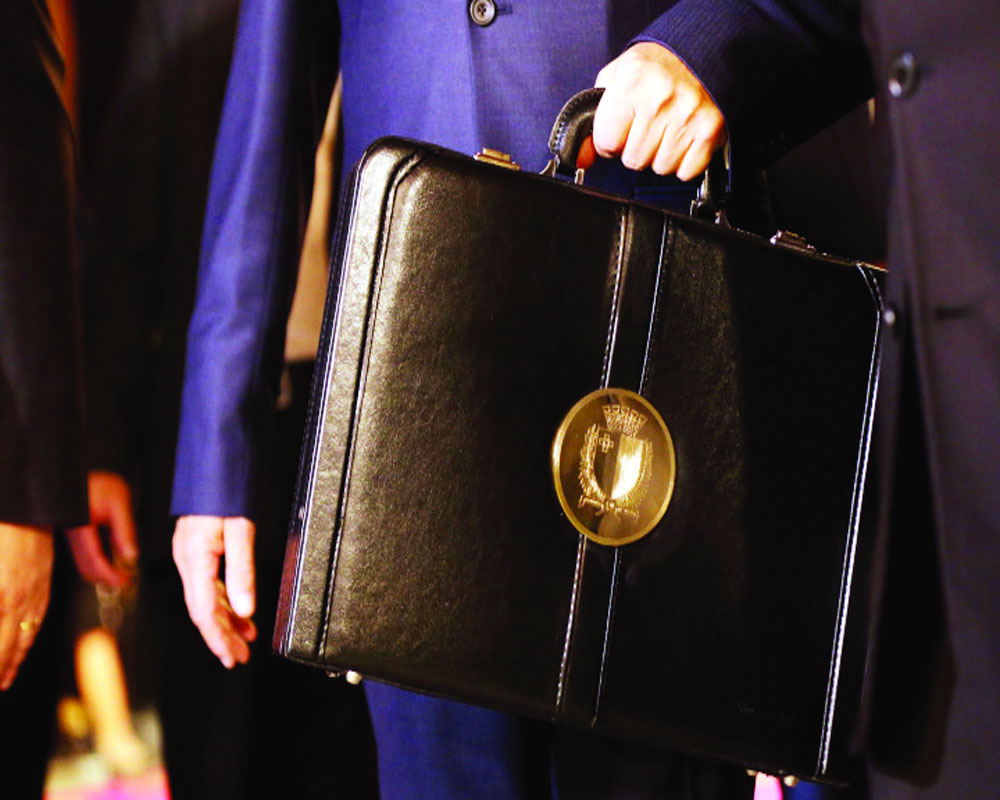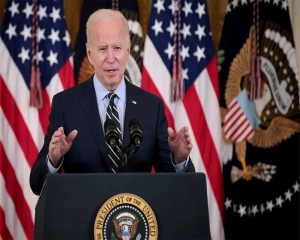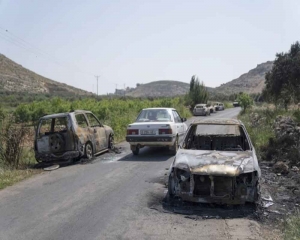The coherence and signature represented by six Modi Budgets is in the emphasis given to long-term nation building and modernisation over populist sops. This has given us the good macroeconomic profile and the international recognition of an economy on the move, writes Gautam Mukherjee
“People think that a liar gains a victory over his victim.”
— Ayn Rand in Atlas Shrugged
A farewell Budget that lays out a 10-year roadmap and a pot of gold $10 trillion strong at 13 years from now, is unusual to say the least. If you think of 2032, when most of our 65 per cent of the population — that is under 35 — will be around, remember $10 trillion puts you in the top three economies of the world in nominal terms, and probably at the very top in PPP terms. This is due to India’s 7-8 per cent GDP growth per annum, year on year compounding away, and expected to power on for the next 30 years. No other major economy can hope for as much with the near certainty that we can. Of course, it presupposes that the great Indian electorate does not plunge this country into chaos by throwing a spanner in the works.
Narendra Modi’s audacity is in his assumption of continuity. He is banking on the good sense of the electorate to see him through. And very deftly, he has moved the time dial for himself forward. In 2014, he used to speak of the need for 10 years to get many things done. At the end of the first five, he wants, health and God willing, a further 13 years — some two-and-a-half terms to retirement or worthy Lotus branded successor.
There is no pleading or grandstanding Congress-style, of “if we are voted back to power”. And this, weeks before the declaration of dates for the General Elections 2019. And in the face of a howling cacophony of an Opposition contemplating a life of irrelevance and powerlessness. The whole country registered the point that Modi thinks he has done well because he has not hesitated to list his Government’s achievements so far. But he also needs more time to see his vision through to its logical conclusion. Given that the other side had nearly six decades, most of them mired in low growth, scarcity, and poverty, it seems like a very reasonable implied request indeed. The foreign media was quick to join a chorus of domestic observers that called it a “campaign Budget” because it tried to include over 70 per cent or more of the electorate in its reach. It was campaign promise, yes, but also an American style “state of the Union” address, and a vision statement, besides being at its minimum the usual set of proposals towards the annual accounting exercise.
The new NSSO data on jobs on which the Opposition has jumped with all the vigour of a pack of ravenous hyenas, is clearly spurious, resignation of its authors notwithstanding. This talk of a 45-year high in unemployment is absurd, because 45 years ago, this country, in the sadistic grip of the Licence-Permit Raj and minus growth rates, was barely allowed to manufacture a sling shot. It, therefore, reads like an old Soviet crop report in its exaggeration and inaccuracy. The half-baked NSSO report was leaked just before the tabling of the Interim Budget on February 1, despite being disallowed by the Government.
It has clearly done no more than a shoddy job of surveying the formal economy. That the private sector in it, mostly benefited by the Congress and its payola systems, and in a sulk ever since it was booted out, along with a mostly unproductive public sector, is not the whole truth, is obvious. The formal private sector, deprived of loans they understood they were not required to pay back, leading to a massive bad debt problems at all the public sector and some private sector banks, has indeed not grown much.
The informal economy, however, which is at 80-90 per cent of the whole, and fuels the robust GDP growth too, is ignored by the lazy babus at the NSSO, who can’t be bothered to survey and enumerate it. But this cannot be ignored with impunity. Certainly not without serious distortions of data. Because, it, the domestic service, the self-employed small entrepreneur, the street vendor, the drivers, helpers, cooks, guards, construction site workers, chowkidars even — is growing much faster than the formal economy!
Along with it are the poorly documented small and medium enterprises, estimated to employ some 200 million people at least. In this Budget, this MSME sector has been given an interest subvention of 2 per cent for loans up to Rs 1 crore.
The broad informal sector has been offered a small monthly pension of Rs 3,000 per month after the age of 60. It is a benefit that will accrue to millions of people. This comes on top of other insurance schemes for the poor, announced earlier, including those for medical insurance, life, and accident insurance. In addition to bank accounts, Aadhaar-based identity authentication, and a massive thrust towards digitisation, the insurance vehicles are definitely a Modi favourite.
The larger benefit for the country is the inclusion of the same millions who work in these sectors, on the statistical rolls. We will know who these people are, where they work, as the pension scheme identifies millions of workers for eligibility. They can qualify for the scheme only by making a monthly contribution of between Rs 55-100, depending on age. It will be, therefore, to an extent, self-supporting, like most insurance schemes are.
In this Interim Budget as a whole, there was the careful balancing act of distributing sops, incentives, and largesse, without impacting the admirable fiscal deficit number as it stands. Certainly not by more than 0.1 per cent, even projected into next year. This was made possible by a doubling of direct tax collections for the very first time. It was a Budget that was responsive to the needs of various sections of the population, and thanked the taxpayer — a first for any Indian Government — for enabling the development programmes of this administration to go forward.
The Modi Government presented, via a stand-in Finance Minister, who is also the Railway Minister, what might have been a vote-on-account. That is if it was an administration with less self-confidence and more reverence for convention. Minister Piyush Goyal — young, fit, fluently bilingual in Hindi and English — presented a substantial Budget through a long speech.
Prime Minister Narendra Modi was there, thumping the table along with his colleagues on the Treasury Benches, in repeated approval of many of the announcements that were made.
The media and the middle classes saw to it that the best received announcement bar none was the one that exempted up to Rs 5 lakh in taxable income from Income Tax. It will benefit an estimated three crore people. And there were hints that people in higher tax brackets might also see some relief when the Budget proposals are confirmed after the elections. This even as a small payment of Rs 6,000 per annum to farmers who own less than five acres of land, has nevertheless remembered another 12 crore people.
This too, like the pension scheme for the informal sector will help identify by name, Aadhaar Card and bank account some 12 crore people who qualify, and will also improve our statistical abilities. States will need to cooperate by supplying much of the information from their land records. But the uses of this captured information will be handy for other benefits too, as they roll out in future.
The Congress was quick to mock at this one, announced early in the Budget speech, seeing their plank of being the farmers’ champion melting away. At just Rs 17 a day, Rahul Gandhi called it an “insult” to the “Indian farmer”. Internet wags promptly mocked him on social media, calling it 0.02 paise per second. This, even as the BJP said the States, particularly the Congress-ruled ones, were at liberty to enhance the amounts to the extent that their purse and conscience could afford. This was probably in oblique reference to the already floundering farm loan waiver schemes announced by the Congress in the three Hindi heartland States they have recently won as well as in Karnataka. This token amount, of course, comes on top of other benefits, such as minimum price guarantees for produce, subsidised fertiliser and low-cost loans and interest waivers — also extended by this Budget to those in fisheries, poultry, and dairy industries.
The moribund real estate sector that accounts for at least 10 per cent of the GDP, ignored for the entirety of the Modi Government so far, despite being a significant employer, has at last been given some benefits. Perhaps the Government saw its relentless emphasis on infrastructure development in preparation for facilitating a $10-trillion economy, as attention enough.
However, the housing, office, retail shopping centres and so on, are definitely a distinct, largely urban area category, and deserve encouragement. Having seen the light on this at last, the present Budget moves on relief in notional rents from second homes. It also includes long-term capital gains from property concessions. This permits buying two homes after the sale of one to a capital gains value of Rs 2 crore, without attracting any tax, but only once in a lifetime.
There were a number of efficiency-oriented announcements, including income tax assessments and refunds within a day, digitised and anonymous scrutiny, single-window clearances for domestic filmmakers, and a massive push for furthering the digital in general as a tool to curb corruption and increase efficiency. Bank fixed deposits might experience a revival because the TDS threshold has been raised from applicability at just Rs 10,000 earned to Rs 40,000.
The Opposition was visibly upset at a near-full Budget instead of a mere vote-on-account, and whined about this for a day or two after the one-hour-45-minute presentation by Goyal. It was nevertheless called a good Budget by experts, the captains of business and industry, the ordinary people, the stock market, and the media.
Various Congress Party grandees, including the Gandhis, sat on in Parliament through Goyal’s cheerful speech, making faces as if they were suffering the full rigours of purgatory. Undaunted, the Budget laid out a 10-point vision statement. It wants to build physical infrastructure fit for a $10-trillion economy. This cannot be faulted, because infrastructure bottlenecks have hampered our progress for decades and stigmatised India as a third world country. Modi also wants a fully digital economy by 2030, probably in line with all of the developed world. Electric vehicles will become de rigeur, as will renewable energy to curb bad air, ground, and water pollution.
Rural industrialisation is an inevitable priority, as more and more people migrate to the cities as a corollary to development seen all over the world. So there will be mechanisation, productivity enhancement, village industry and so on, to transform the countryside. Clean rivers are starting to become a reality for the first time with sewage and chemicals being processed instead of being allowed to pollute the rivers. This trend will be strengthened going forward even as Ganga water has shown improvement for the very first time. Let us remember that there were no fish in the Thames because it was so polluted before conservation measures were put in place. There will be a scaling up of the Blue Water Economy using the flagship Sagarmala and other projects. The Space Programme will send an Indian to space by 2022 and India will become the world’s go-to place for the launch of satellites.
Food self-sufficiency, already a thing achieved, must be maintained using sustainable farming practices. Comprehensive education and healthcare for all is on its way to becoming a reality, but is also a basic requirement for a developed economy. Improved Government efficiency as a goal is probably the hardest to achieve, but can come about if permanent tenure is removed.
The biggest defence Budget ever at Rs 3 lakh plus crore, however, is grossly inadequate, considering the backlog of work towards modernisation of the equipment for the armed forces. This will have to be reinforced liberally off Budget. The Budget for the Indian Railways towards modernisation, greater connectivity, and growth, has been enhanced, as it is on its way to revival and profitability once again. It is indeed a proud achievement that all unmanned level crossings on the broad gauge network have now been eliminated. People need not die at them anymore. Civil aviation is growing by leaps and bounds as over a million people use it daily to travel to and from 100 airports domestically.
There are many other aspects of this Budget, both in the headlines and the fine print. But suffice is to say that it plans to increase expenditure significantly without wrecking the fiscal deficit. Let us hope the Government’s substantial divestment PSU programme, which has not gone particularly well, does not queer the pitch. The lending and rating agencies will be watching for fiscal slippage.
Is this Budget, responsive as it is, too little too late in the day to seriously influence the coming elections? This depends on what one thinks of both public memory and attention span. Modi clearly thinks that it is best to do welcome things as close to the General Elections as possible. The coherence and signature represented by the six Modi Budgets is in the emphasis given to long-term nation building and modernisation over populist sops. It is this that has given us the good macroeconomic profile and the international recognition of an economy on the move.
Of course, at the grassroots level, this Budget acknowledges that there is much that remains to be done. But the Opposition seems to be considerably behind the curve on this, because it relies heavily, as always, on the gullibility of the voter and its response to the promise of immediate benefit, however fraudulent. It has even worked for them to an extent electorally very recently. Will it do the trick in a couple of months? My guess is that it is advantage Narendra Modi all the way.


























